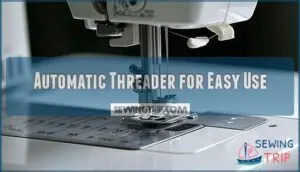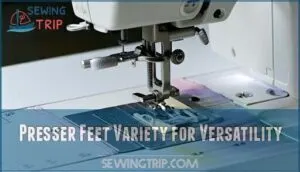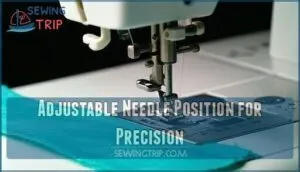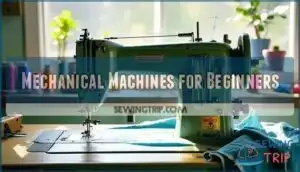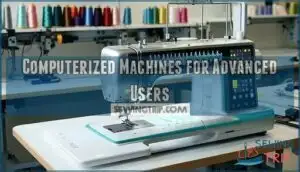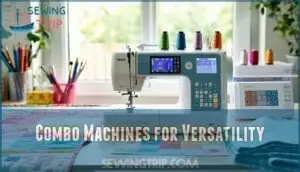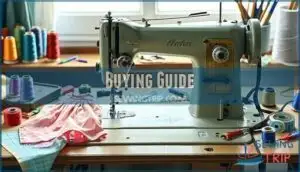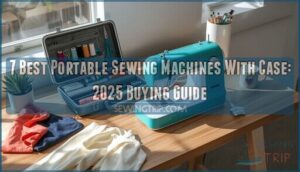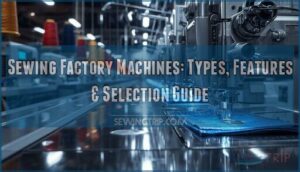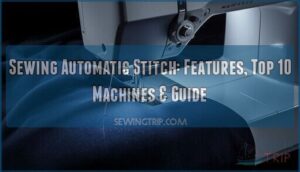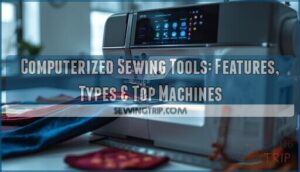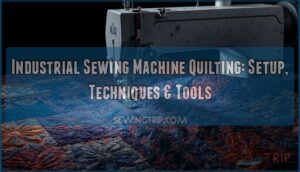This site is supported by our readers. We may earn a commission, at no cost to you, if you purchase through links.
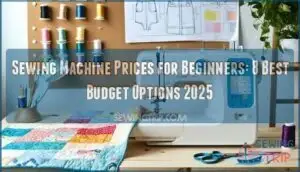
Mechanical models start around $100-$150, offering basic straight and zigzag stitches that’ll handle most starter projects.
Computerized versions run $150-$300, adding automatic features like buttonholes and stitch selection.
Don’t get caught up chasing fancy bells and whistles – a reliable machine with consistent tension beats a temperamental one with fifty stitches you’ll never use.
Focus on sturdy construction, easy threading, and clear instruction manuals.
The sweet spot for most newcomers sits between $150-$200, where you’ll find machines that won’t frustrate you but won’t break the bank either.
Smart shopping means knowing which features actually matter.
Table Of Contents
- Key Takeaways
- Sewing Machine Costs
- Top 8 Sewing Machines
- 1. Brother CS7000X Sewing and Quilting Machine
- 2. Mini Electric Sewing Machine Full Set
- 3. SINGER M1000 Portable Mending Machine
- 4. SINGER M3500 Sewing Machine Lightweight Portable
- 5. Brother Computerized Sewing Quilting Machine
- 6. Brother SE700 Sewing Embroidery Machine
- 7. Magicfly Mini Sewing Machine Kit
- 8. SINGER Heavy Duty Sewing Machine 4452
- Essential Features
- Sewing Machine Types
- Buying Guide
- Frequently Asked Questions (FAQs)
- Conclusion
Key Takeaways
- You’ll spend $100-$300 for a quality beginner sewing machine, with the sweet spot being $150-$200 for reliable performance without breaking your budget.
- Focus on sturdy construction and consistent stitch quality over fancy features—a machine with 20 reliable stitches beats one with 100 temperamental options you’ll never use.
- Mechanical machines ($100-$150) offer simplicity and easy repairs, while computerized models ($150-$300) provide automatic features like buttonholes and needle threading for added convenience.
- Don’t forget ongoing costs—budget for annual servicing ($75-$100) and consider warranty coverage, as a reliable machine with good support saves money and frustration long-term.
Sewing Machine Costs
When you’re looking at sewing machine costs, you’ll notice prices can range from under $50 for basic models to $300 or more for machines with advanced features.
It’s important to compare what each machine offers, like stitch options and build quality, so you get the best value for your budget.
Factors Affecting Price
Several key factors drive beginner sewing machine prices, creating a wide range from budget-friendly to premium options.
Understanding these elements helps you make smart purchasing decisions within your sewing machine budget.
- Material Quality – Metal frames cost more than plastic but last decades longer
- Brand Reputation – Established names like Brother command higher prices for reliability
- Feature Set – More built-in stitches and computerized controls increase affordable sewing machine costs
- Included Accessories – Complete kits with presser feet and bobbins add value
- Warranty Length – Extended coverage reflects manufacturer confidence and affects sewing machine prices
Budget Options for Beginners
When you’re weighing sewing machine prices, don’t overlook a used machine or DIY kits—they’re budget-friendly and often reliable.
Rental options and shared resources, like community makerspaces, help you test models before buying.
Discount events can bring a cheap sewing machine or affordable sewing machine within reach.
Entry-level sewing machine cost can drop below $100 if you shop smart. Some models offer great beginner-friendly features at this price point, making them a good option for those looking for beginner-friendly machines.
Value Considerations for New Users
Value goes beyond the sticker price when choosing your first beginner sewing machine.
Look for stitch consistency across different fabrics and long-term reliability backed by solid warranty coverage.
Factor in maintenance costs and local servicing availability. An affordable sewing machine that breaks after six months isn’t truly budget-friendly.
Easy to use sewing machine features justify higher sewing machine prices. Some sewers find that quality materials matter for long-term use.
Top 8 Sewing Machines
You’ll find eight budget-friendly sewing machines that deliver quality performance without breaking the bank.
These carefully selected options range from basic mechanical models to feature-rich computerized machines, all priced to fit a beginner’s budget.
1. Brother CS7000X Sewing and Quilting Machine
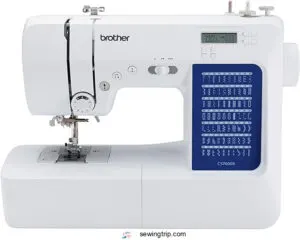
When you’re ready to invest in quality without breaking the bank, the Brother CS7000X delivers exceptional value at around $150.
This computerized machine features 70 built-in stitches and seven automatic buttonhole styles, making it perfect for beginners who want room to grow.
You’ll appreciate the improved automatic needle threader and jam-resistant drop-in bobbin that eliminate common frustrations.
The LCD display simplifies stitch selection, while the included wide table handles larger projects with ease.
At 10.4 pounds, it’s portable yet sturdy enough for consistent results, and offers a great combination of features, including the automatic needle threader.
Best For: Beginners and intermediate sewers looking for an affordable, versatile computerized machine with quilting features.
- Small, unlit LCD screen may be hard to read for those with poor eyesight.
- Minor difficulty installing zippers due to presser foot height limits.
- Plastic components require careful maintenance to ensure durability.
- 70 built-in stitches and 7 automatic buttonhole styles provide versatility.
- Improved automatic needle threader and jam-resistant bobbin for ease of use.
- Lightweight and portable with included wide table for larger projects.
2. Mini Electric Sewing Machine Full Set
![Sewing Machine Prices for Beginners: 8 Best Budget Options 2025 2 KPCB Sewing Machine [Full Set] B0BQJ9CRGP](https://sewingtrip.com/wp-content/uploads/2024/03/kpcb-sewing-machine-full-set-b0bqj9crgp-293x300.jpg.webp)
This compact powerhouse fits in your palm but packs surprising capability for basic repairs and small projects.
Measuring just 8.6×6.9×3.5 inches, it handles up to five fabric layers with its double-thread design.
The 42-piece accessory kit includes everything you’ll need to start sewing immediately.
While some users report durability issues, others praise its portability and ease of use.
At under $60, it’s perfect for occasional mending tasks, though serious sewers should consider upgrading to a standard machine for long-term projects.
Best For: Beginners and casual users who need a portable, easy-to-use sewing machine for light repairs and small projects.
- Reported durability problems, with some units breaking quickly.
- Limited power and features, not suitable for heavy or long-term sewing.
- Some users find repairs time-consuming and the machine noisy.
- Compact and lightweight, making it easy to store and carry.
- Includes a comprehensive 42-piece accessory kit to get started right away.
- Handles up to five layers of fabric with a stable double-thread design.
3. SINGER M1000 Portable Mending Machine
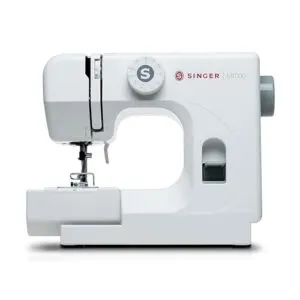
If you’re dipping your toes into sewing, the SINGER M1000 Portable Mending Machine might fit your needs.
This machine packs 32 preset stitches, a top drop-in bobbin, and a stitch selector dial into a lightweight, 5.5-pound frame.
It’s easy to carry, making it handy for small spaces or travel.
Threading guides and preset settings simplify setup, though you’ll want to watch out for occasional bobbins jams.
It’s best for quick fixes and light sewing—don’t expect it to handle heavy denim.
Best For: Beginners and casual sewers who need a lightweight, portable machine for quick mending, hemming, and simple alterations in small spaces.
- Extremely portable at 5.5 pounds with compact design perfect for travel and small spaces
- Beginner-friendly with 32 preset stitches, threading guides, and simple stitch selector dial
- Budget-friendly pricing typically under $110 with excellent value for basic sewing needs
- Cannot handle heavy fabrics like thick denim or multiple layers due to lightweight construction
- Limited customization with preset-only stitch length and width settings
- Reliability issues including bobbin jams, thread breaks, and occasional mechanical problems
4. SINGER M3500 Sewing Machine Lightweight Portable
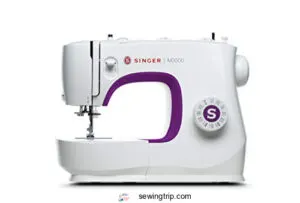
The SINGER M3500 packs a punch for its price, offering 32 stitches, a one-step buttonhole, and an automatic needle threader.
You’ll appreciate its lightweight design—easy to carry and store—plus LED lighting for clear visibility.
It handles everything from sheers to denim, though it’s not built for heavy-duty work.
Some users report bobbin jams, so practice makes perfect.
With an average price around $140-$180, bundled accessories, and a sturdy metal frame, it’s a solid pick for beginners aiming for versatility.
Best For: Beginners and hobbyists looking for a lightweight, versatile sewing machine for everyday projects and light to medium fabrics.
- Lightweight and portable with a sturdy metal frame
- Includes 32 stitch options plus one-step buttonhole and automatic needle threader
- LED lighting and bundled accessories add value for beginners
- Frequent bobbin jams reported, requiring practice to master
- Not suitable for heavy-duty or professional sewing tasks
- Voltage incompatibility for UK users without an adapter
5. Brother Computerized Sewing Quilting Machine
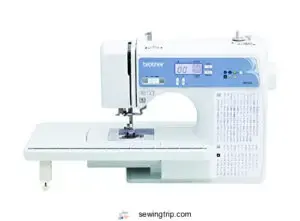
Why settle for basic when you can have versatility? Brother’s computerized sewing and quilting machines deliver impressive functionality without breaking your budget.
The XR9550 features 165 built-in stitches, including 55 alphanumeric options and 8 automatic buttonhole styles. You’ll appreciate the LCD screen for easy stitch selection and the automatic needle threader that saves time.
With its jam-resistant drop-in bobbin and free arm capability, this machine handles everything from lightweight fabrics to quilting projects. The included wide table and instructional DVD make learning straightforward for beginners, providing a great way to experience impressive functionality.
Best For: Quilters and sewists looking for an affordable, versatile machine with advanced features for both sewing and quilting projects.
- Offers 165 built-in stitches, including alphanumeric and buttonhole styles.
- Features an automatic needle threader and jam-resistant drop-in bobbin for convenience.
- Includes a wide table and instructional DVD, great for beginners and quilting tasks.
- Limited to lightweight fabrics, not suitable for heavy-duty sewing.
- Some users find the threading area narrow and needle access awkward.
- Extension table may be fragile and require careful handling.
6. Brother SE700 Sewing Embroidery Machine
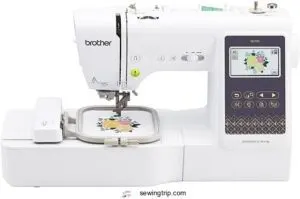
The Brother SE700 stands as a powerhouse that bridges sewing and embroidery worlds.
You’ll get 135 built-in embroidery designs and 10 fonts, plus 103 sewing stitches with 10 buttonhole styles.
The 4" x 4" embroidery field and 3.7" touchscreen let you preview designs before stitching.
Wireless connectivity pairs with the Artspira app for custom patterns.
The machine’s Artspira app compatibility allows for wireless pattern transfers.
While beginners praise its functionality, some struggle with setup instructions and prefer YouTube tutorials over the manual, seeking a better learning experience.
Best For: Beginners and hobbyists looking for a versatile machine that combines sewing and embroidery with easy-to-use features.
- Wide variety of built-in embroidery designs and sewing stitches.
- Intuitive 3.7" touchscreen for design editing and preview.
- Wireless connectivity for transferring custom patterns via the Artspira app.
- Setup instructions can be unclear, making learning difficult without extra help.
- Some users report durability and stability concerns.
- Connectivity and app integration sometimes cause frustrations.
7. Magicfly Mini Sewing Machine Kit
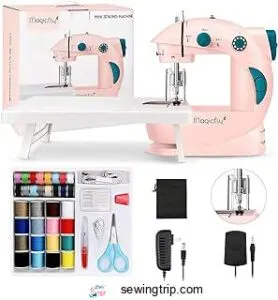
This compact powerhouse packs surprising capability into its petite frame.
It operates on batteries or AC power, making it perfect for dorm rooms or travel projects.
You’ll get dual-speed control and double-thread stitching for stronger seams.
The kit includes 32 bobbins, needles, scissors, and an extension table.
While it handles light fabrics well, don’t expect heavy-duty performance.
The tension requires careful adjustment to avoid jamming.
At this price point, it’s ideal for kids learning basics or quick mending tasks around the house.
Best For: Beginners, kids, or anyone needing a portable, easy-to-use sewing machine for light fixes and simple projects.
- Dual power (AC/DC or battery) for easy use anywhere.
- Double-thread stitching for stronger seams.
- Includes a generous accessory kit and extension table.
- Struggles with thick or heavy fabrics.
- Tension can be finicky and requires careful adjustment.
- Mixed durability; some users report quality issues.
8. SINGER Heavy Duty Sewing Machine 4452
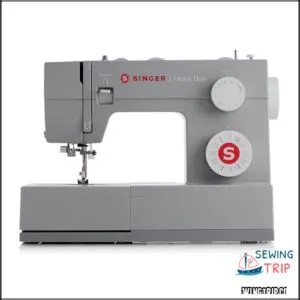
When durability meets power, you get a machine built for serious projects.
The SINGER Heavy Duty 4452 delivers 50% more piercing power than standard models, handling multiple denim layers with ease.
Its metal frame guarantees stability while stitching at 1,100 stitches per minute.
You’ll get 32 built-in stitches, automatic needle threader, and six specialty presser feet.
At around $270, it’s pricier than basic machines but offers professional-grade performance for ambitious beginners tackling heavy fabrics.
Best For: Sewers who need power to handle heavy fabrics like denim, canvas, and vinyl while wanting built-in convenience features and reliable performance.
- 50% more piercing power than standard machines with 1,100 stitches per minute for tackling thick, challenging fabrics
- Metal frame construction provides exceptional stability and durability for long-term use
- Comprehensive package includes 32 stitches, automatic needle threader, and six specialty presser feet worth over $120
- Noisy operation during use, which may be disruptive in quiet environments
- Heavy weight makes portability challenging despite the included carrying handle
- Some users report difficulty with presser foot attachment and occasional thread jamming issues
Essential Features
When you’re starting your sewing journey, three key features can make or break your experience with a beginner machine.
An automatic needle threader saves you from squinting and fumbling with tiny threads, while multiple presser feet give you the flexibility to tackle different projects from hemming pants to sewing zippers.
Automatic Threader for Easy Use
You’ll find automatic threading technology on many beginner sewing machines, making needle threading quick and simple.
This feature reduces eye strain and frustration for new sewers. Threader Benefits include faster setup and consistent threading accuracy.
However, Threader Limitations exist – some models require specific needle sizes. Threader Maintenance involves keeping the mechanism clean from lint buildup.
Many users appreciate the automatic needle threading found on Singer models. Most affordable sewing machines offer Threader Compatibility with standard needles, though Threader Alternatives like manual threading remain reliable backup options.
Presser Feet Variety for Versatility
Variety in presser feet transforms your beginner sewing machine into a versatile tool.
Most affordable sewing machines include basic specialty feet like zipper, buttonhole, and blind hem attachments.
These sewing machine accessories expand fabric compatibility beyond cotton to handle different materials and weights.
Foot pressure adjustments help manage delicate fabrics.
Specialized feet enhance sewing capabilities.
Aftermarket options open up creative techniques for decorative stitching and professional finishes, allowing for professional finishes.
Adjustable Needle Position for Precision
Needle position control transforms your beginner sewing machine into a precision tool for fabric manipulation.
You’ll create precise seams by adjusting the needle left, center, or right.
This feature enhances decorative stitching accuracy and improves quilting applications.
Perfect button placement becomes effortless when you can shift the needle position for topstitching and edging work on your easy to use sewing machine.
Sewing Machine Types
When choosing your first sewing machine, you’ll encounter three main types that cater to different skill levels and budgets.
Mechanical machines use simple dials and switches, making them affordable and reliable for beginners, while computerized machines offer automatic settings and advanced features that appeal to users ready for more complex projects, with mechanical machines providing a basic alternative.
Mechanical Machines for Beginners
Mechanical sewing machines offer Simple Operation through manual dials and switches, making them perfect for new sewers.
These basic sewing machine models feature excellent Repair Ease since they’ve fewer electronic components.
Most entry level sewing machine options provide 6-32 built-in stitches for adequate Stitch Selection.
Their Durable Build with metal frames guarantees longevity, while the gentle Learning Curve helps beginners master fundamentals without overwhelming complexity.
Beginners often find it helpful to start with a machine that offers essential built-in stitches for basic projects.
Computerized Machines for Advanced Users
While mechanical machines get you started, computerized options offer precision control with advanced features that streamline complex projects.
These machines handle automatic buttonhole sizing and provide extensive builtin stitches for creative flexibility.
- Stitch customization lets you adjust length, width, and tension settings through digital displays
- Embroidery options and quilting capabilities expand your project possibilities beyond basic sewing
- Software updates keep your computerized machine current with new patterns and features
Combo Machines for Versatility
If computerized models feel a bit much, combo machines step in, offering Hybrid Features for both sewing and embroidery.
You get more Stitch Options, but the Learning Curve rises.
These combos expand your Project Scope, though Repair Complexity can increase.
Many models include automatic needle threaders for convenience.
Combo machines sit in a higher price range, but they’re a smart pick when you want a beginner sewing machine that grows with you.
| Feature | Combo Machines | Mechanical | Computerized | Cost Range | Project Scope |
|---|---|---|---|---|---|
| Hybrid Features | Yes | No | Some | $$-$$$ | Broad |
| Stitch Options | 50+ | 10-20 | 50-200 | $200-$600 | Versatile |
| Learning Curve | Moderate | Low | Moderate | $100-$300 | Expanding |
| Repair Complexity | Moderate | Low | High | Varies | Growing |
| Best For | Versatility | Simplicity | Tech Lovers | Beginners | Multi-purpose |
Buying Guide
When you’re choosing a sewing machine, you’ll need to look at value, performance, and long-term costs like maintenance.
This guide explains how to compare features, check repair needs, and pick a machine that matches your sewing projects and budget.
Evaluating Machine Value and Performance
When you’re shopping for your first beginner sewing machine, look beyond the price tag.
Check stitch consistency across different fabrics – this tells you about real sewing machine performance.
Read user reviews carefully to spot patterns about reliability and durability.
Compare warranty length between models, as longer coverage often signals better sewing machine value.
Factor in potential maintenance costs and confirm local servicing options are available.
Smart evaluation helps you find truly affordable sewing machines that deliver lasting results.
Considering Maintenance and Repair Costs
Budget for ongoing expenses when choosing your sewing machine. Routine servicing costs $75-$100 annually, while repairs can reach $250 for major issues. Mechanical machines typically cost less to maintain than computerized models.
- Repair Frequency – Basic machines need professional servicing every 12-18 months with regular use
- DIY Repairs – Simple cleaning and oiling reduce costly breakdowns and extend machine life
- Servicing Options – Local repair shops charge $45-$60 per hour for labor plus parts
- Warranty Coverage – Most beginner machines include 1-3 year warranties covering manufacturing defects
Choosing The Right Machine for Your Needs
With so many affordable sewing machines out there, think about your Project Complexity, Skill Level, and Space Constraints.
If you’re eyeing thick Fabric Types or Future Projects, pick a beginner sewing machine with room to grow.
The best starter sewing machine balances features and cost, and finding the right sewing machine can be a game changer.
For tight spaces, an entry level sewing machine keeps things tidy and practical, considering your Space Constraints.
Frequently Asked Questions (FAQs)
How much does a beginner sewing machine cost?
Don’t worry, you won’t need to break the bank.
Entry-level sewing machines usually range from $100 to $
For a reliable starter, aim for $150–$
Cheaper options exist, but durability may be limited.
Are cheap sewing machines good for beginners?
Cheap sewing machines can work for beginners if you’re just learning basics. However, machines under $100 often lack durability and consistent stitch quality, potentially creating frustrating experiences that discourage new sewers.
Where can I buy a sewing machine?
You can find sewing machines at craft stores like Joann Fabrics, big retailers such as Walmart or Target, and online at Amazon or sewing specialty sites.
Check local classifieds for deals, or visit a sewing machine dealership.
What is the best sewing machine for beginners?
You’ll love the Brother CS7000X for its easy threading, 70 built-in stitches, and helpful guides.
It’s user-friendly, reliable, and comes with handy accessories, making it perfect for learning, experimenting, and growing your sewing skills.
What are the best cheap sewing machines?
You’ve got solid options like the Brother XM2701, Singer M662, and Janome Easy-to-Use.
These machines deliver reliable stitches, user-friendly controls, and portability—perfect for beginners who want practical features without breaking the bank.
Are affordable sewing machines available online?
You might think snagging a solid sewing machine online is a tall tale, but it’s true.
You’ll spot beginner-friendly models from trusted brands like Brother and Singer, packed with essential features, all just a click away.
How much should a beginner spend on a sewing machine?
You should budget $150-$200 for a reliable beginner sewing machine. This range gets you essential features like automatic threading, built-in stitches, and solid construction without breaking the bank.
What is the average price of a good sewing machine?
Coincidentally, just as thread tension matters for perfect stitches, pricing varies widely.
Sewing machines range from $200 to nearly $20,000, but quality models typically cost $300-$800, offering reliable performance without breaking your bank.
What should I buy as a beginner sewing?
Start with a reliable beginner sewing machine, like the Brother CS7000X or Singer M
Focus on models with easy threading, built-in stitches, and clear instructions.
Add basic supplies—thread, fabric, scissors—to practice and build confidence.
Add these basic supplies to a machine with easy threading, and you are ready to start sewing.
How to pick a beginner sewing machine?
Choose a machine that matches your skill level and project goals.
Consider your budget ($100-300), preferred features (automatic threading, built-in stitches), and whether you want mechanical simplicity or computerized convenience for learning.
Conclusion
Compare features, compare prices, compare ease of use—when you’re looking at sewing machine prices for beginners, it’s all about finding the right fit for your needs.
Focus on sturdy construction, simple threading, and essential stitches, not just flashy extras.
Remember, a reliable machine saves frustration and helps you build skills. Whether you choose mechanical or computerized, prioritize value and support.
Smart shopping means you’ll start sewing with confidence, without stretching your budget or patience.
- https://www.applegreencottage.com/best-sewing-machine-for-beginners/
- https://www.nytimes.com/wirecutter/reviews/best-sewing-machine/
- https://www.reddit.com/r/sewing/comments/pmjrmr/what_is_a_good_cheap_sewing_machine_for_a_beginner/
- https://seekatesew.com/best-sewing-machine-under-200/
- https://sewjoyfulteaching.com/blogs/news/best-sewing-machines-for-beginners-2025

